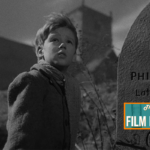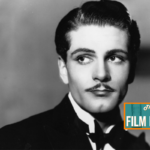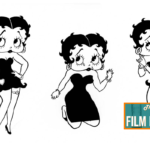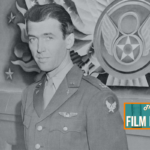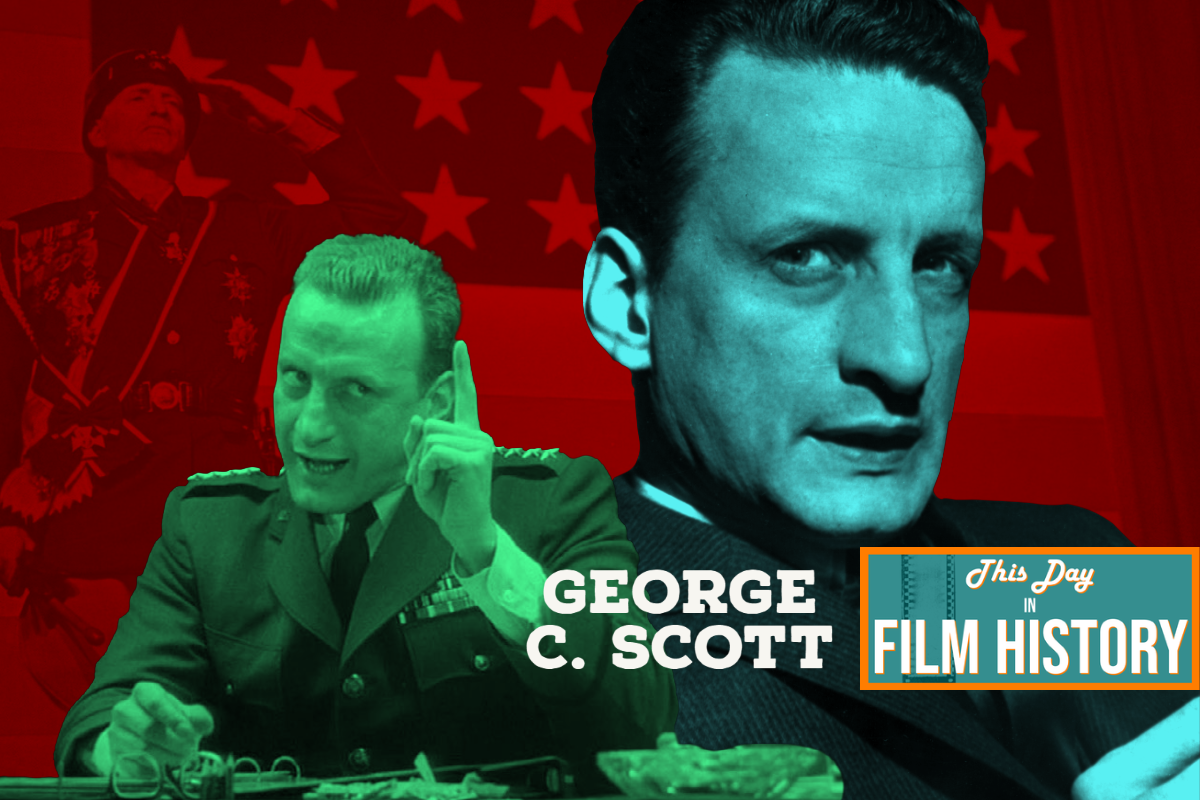
When you enter the name of George C. Scott into your respective search engine, and browse through the various articles that appear, there are many words that fit the character, but fail to truly understand the man himself: courageous, bold, commanding, a battler, stern, difficult, headstrong, outspoken, among other things. The world has rarely known an actor of such mystique, passion, and commitment. A very impressive actor, to say the very least, who was his own worst enemy. His genius won him an Oscar (which he refused) among four nominations, two Primetime Emmys among eight nominations, two BAFTA nominations,five Tony nominations and two Golden Globes among five nominations, along with an incredible and undeniable legacy that outshines any of those accomplishments. This Day in Film History’s October Actor Spotlight shines on the astounding George C. Scott.

Early Days
George Campbell Scott was born in Wise, Virginia on October 18th, 1927. His mother, Helena, passed away when George was nearly eight years old. While in school, and well before his acting, he had wanted to be a writer in the vein of F. Scott Fitzgerald, his favorite writer. But, once he graduated high school, he served in the Marine Corps from 1945-1949. He was an honor guard for funerals that were held at Arlington National Cemetery, which led him to pick up a drinking habit. After leaving the Corps, he attended the University of Missouri to study journalism. But, he subsequently found a knack for drama while performing in plays. He made his first public appearances on stage in productions put on by the university, and graduated in 1953 with a degree in theater.
Scott began the climb to stardom following his college graduation,with 1958 being a landmark year for his career. He gained popularity while working with Joseph Papp’s New York Shakespeare Festival, made his broadway debut with “Comes a Day,” and debuted on television in a production of “A Tale of Two Cities.”
Film and TV Breakthroughs
The next year, George C. Scott made his first appearance in a feature film with the Delmer Daves directed/Gary Cooper starring movie, “The Hanging Tree.” His second film, however, landed him his first Oscar nomination, being nominated for Best Supporting Actor for his work in “Anatomy of a Murder.” But, if you know about his history with the Academy Awards, you know that this wasn’t something he sought after. His first nomination became his first refusal from the Academy, believing the ceremony to be nothing more than a meat market. Later in 1959, he continued his work on Broadway with “The Andersonville Trial.” He’d go on in the subsequent years to perform in “The Wall,” and guest star on TV shows such as “Dow Hour of Great Mysteries,” Playhouse 90,” and “Play of the Week.”
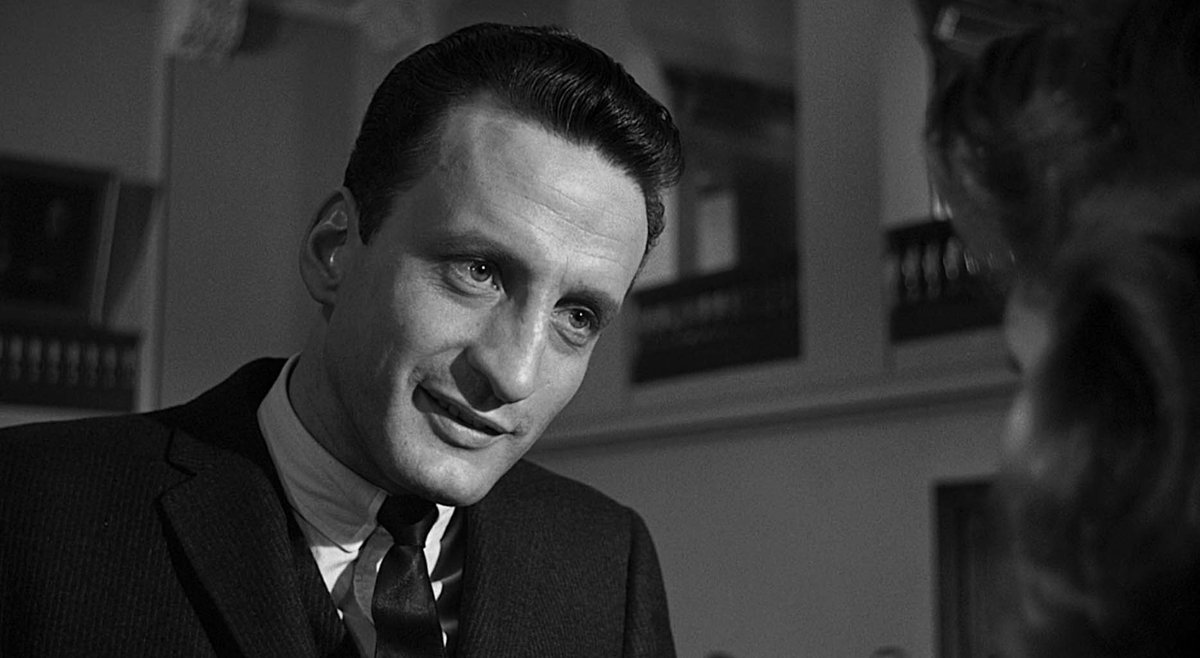
The second Oscar nomination for Scott came after starring alongside Paul Newman in 1961’s “The Hustler,” once again nominated for Best Supporting Actor, once again refusing the nomination. Following this, and a brief return to broadway, he made various guest appearances on television. From “The Virginian” to “The Eleventh Hour” and the television movie “The Power and the Glory” with Laurence Olivier.
The first time Scott was the leading man in a film was with John Huston’s “The List of Adrian Messenger” in 1963. Later on in the same year, Scott would star in the CBS show “East Side/West Side,” where he’d have creative influence.
Things picked up in a major way when he starred in Stanley Kubrick’s “Dr. Strangelove or: How I Learned to Stop Worrying and Love the Bomb,” an anti-war black comedy (which happens to be where I first saw and loved George C. Scott, as it’s my favorite movie.) The film was (and still is to this day) highly regarded as one of the best comedies, one of the best satires, and one of the best films ever made, period. Many will point to the trio of performances from Peter Sellars, but for me, it’s George C. Scott that steals the show, especially upon learning how his performance came to be. In order for Kubrick to get such a wild performance from Scott, he had to play a wild game of mental chess (we’ll circle back to literal chess in a moment.)
Kubrick would trick Scott by telling him to rehearse the scene with wild and animated mannerisms, telling him it was an exercise for the scene and that the takes with his ridiculous performance would not be in the final cut of the film. This was a bold-faced lie, one which Scott felt betrayed by. The scenes left in were, of course, with his wildest takes. When he became insistent on not performing the way Kubrick wished to direct the scene, they’d settle the debate the way all gentlemen should settle differences: with games of chess on set. More often than not, Kubrick would win. Because of the differences they had, and because of Scott’s feeling of betrayal, he swore that he would never work with Kubrick again. Sure enough, that was just the case, but later in life, Scott would admit that this was one of his favorite performances, even stating he hated being paid for it because he had fun making it.
The sixties proved to be a busy decade for Scott. After “Dr. Strangelove,” his film credits include“The Yellow Rolls-Royce,” “The Bible: In the Beginning,” “Not with My Wife, You Don’t,” “The Flim-Flam Man,” and “Petulia,” along with the TV movies “The Crucible,” “This Savage Land,” “Mirror, Mirror Off the Wall,” and appearing in TV shows such as “The Red Skelton Hour,” and“Bob Hope Presents the Chrysler Theatre.
Major Force in Hollywood
With 1970’s “Patton, “George C. Scott, two time Oscar nominee” became “George C. Scott, Oscar winner,” and in typical fashion, Scott believed himself to not be in competition with the other actors nominated, and refused the award. Nevertheless, Scott’s performance became the highlight in a movie that was stacked to the brim with prestige. The film, produced by Frank McCarthy, won Best Picture (McCarthy gave the award to the George C. Marshall Foundation Library in Lexington, Virginia.) Director Franklin J. Schaffner won Best Director. Francis Ford Coppola and Edmund H. North won Best Writing. Hugh S. Fowler won Best Film Editing. The film also picked up Best Art Direction and Best Sound, Along with nominations for Alex Weldon’s special effects, Jerry Goldsmith’s original musical score, and Fred J. Koenekamp’s cinematography. Seven Oscar wins out of ten nominations, but Scott’s work is what stands the test of time the most in this triumph of a film.
His portrayal of the controversial General Geroge S. Patton is uncanny and is a masterpiece within a masterpiece. George C. Scott was truly a performer beyond the recognition of the Academy, even though that didn’t stop them from nominating him one more time for “The Hospital.” He did, however, not turn away the New York Film Critics award for his performance, which his ex-wife claimed was the only award he thought was worth having.
In the 1970s Scott starred in “Jane Eyre” and “The Price,” both made for television, and the latter winning him an Emmy (another award he accepted.) Other television movies during this decade included “Fear on Trial” and “The Hindenburg.” He also directed “The Andersonville Trial” in 1970. He followed up with feature films “They Might Be Giants,” “The Last Run,” “The New Centurions,” the aforementioned “The Hospital.” “Rage”, “Oklahoma Crude,” “The Day of the Dolphin,” “Bank Shot,” and “The Savage is Loose.”
Once again, George C. Scott returned to Broadway. In the late sixties, he performed in Plaza Suite, which ran for 1,097 performances and received acclaim. He also directed productions of “All God’s Chillun Got Wings,” and “Death of a Salesman.” Other notable Broadway productions he either starred in or directed during this time include “Uncle Vanya,” “Sly Fox,” and “Design for Living.” By the end of the decade, he had racked up more appearances on television and in supporting and cameo roles in film, including “Islands in the Stream,” “Crossed Swords,” and a TV adaptation of “Beauty and the Beast.”
Late in His Career

The eighties brought back more starring roles for Scott, with “The Changeling,” The Formula,” and “Taps.” He also starred in a couple of made for TV adaptations of Charles Dickens’ works: first as Fagin in CBS’s “Oliver Twist” and then as Ebenezer Scrooge in 20th Television’s “A Christmas Story.” The latter half of this decade saw him stick with more television shows and movies than feature films.
His last decade brought him back to film and Broadway, with appearances in “The Exorcist III,” “Malice,” “The Whipping Boy” and “Tyson,” and directing/appearing in “On Borrowed Time,” along with his final Emmy winning performance as Juror No. 3 in MGM Television’s made for TV remake of “12 Angry Men.” His final performance on screen was with “Inherit the Wind,” with “12 Angry Men” co-star Jack Lemmon.

Death and Family
George C. Scott was prone to heart attacks in the eighties and passed away from a ruptured abdominal aortic aneurysm on September 22nd, 1999. He was laid to rest to the left of where Walter Matthau was buried a year later, in Westwood Village Memorial Park Cemetery. Scott had married a total of five times, and had six children, including Campbell Scott.
Scott’s commanding screen presence was clearly a translation to real life as well. He was a strong force, stern, stubborn, and commanding. And, yet, he gained respect in the industry, respect that still holds over two decades after his death. His performances are legendary, from Ebenezer Scrooge to General Patton to Buck Turgidson to Bert Gordon, and have stood the test of time. With his commitment to his craft, respect to fellow actors, and larger-than-life personality, it’s safe to say there never has been anyone quite like George Campbell Scott. One of the absolute best and most dedicated performers to ever grace film, TV, and stage work.
We here at This Day in Film History thank you for reading, and want you to let us know what your favorite performance from the legendary George C. Scott is! Make sure to like, comment, share, and follow us on social media for more articles and history posts. But before you go, I just wanted to remind you that, like George C. Scott, the world is a better place for having you in it. I’m proud of you for getting up and tackling whatever this day has in store for you. Be sure to be kind to yourself today, and don’t sweat the small stuff. You deserve the peace that comes from letting go of the angst of trivial issues.



